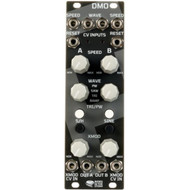DMO - Rides in the Storm
by Ian Rapp
Rides in the Storm adds to their stable of excellent modules with DMO (it stands for “Dual Modulator”), a two-channel LFO/VCO. When I first saw DMO and glanced at its basic functions, I was thinking that it looked useful. I mean, more LFOs? Yes, please. But like the rest of Rides in the Storm modules there’s always something extra that elevates them, and DMO doesn’t break this thread. But we’ll get to that.
DMO has two nearly identical channels with a Speed control, Wave/PWM control, a Wave selector switch (triangle-based or PWM), an “Extra Waveform” button (Channel 1 can be a S&H, Channel 2 a sine wave), and an XMod control (the special sauce). There are CV inputs for SPEED, Xmod and Crossfading the waves or PWM—depending on your wave settings—and Reset inputs for each channel.
Yes, a lot of LFO modules can do audio rate, performing as VCOs along with doing the dishes and your taxes, but DMO makes this more worthwhile than flexing in front of a mirror as DMO makes a great two-channel oscillator with good 1V/Oct tracking. Honestly, I could listen to a modulated pulse wave all day—that’s a given—but DMO also lets you choose between a saw, triangle and ramp and everything in between, and modulating—cycling through and between those—is kind of a pointier version of PWM. While it doesn’t have the same magnetism, it’s starting to grow on me, this TWM (triangle wave modulation)—if you will—especially softened via filtering.
DMO’s special sauce is the Xmod, the ability for each channel to FM the other in various amounts and for this to be CV controlled. This produces some nice tones and becomes especially more animated when modulation is introduced into a channel’s XMod CV input by another LFO/VCO. Ring mods, metallic under and overtones, and chaotic—yet many times very controlled—noise and much more can be had. I did find myself surprised at how much I enjoyed DMO as a VCO. It can bring a unique flavor, do its own thing in this realm, and while it isn’t going to nudge your typical powerhouse dual-complex oscillator out of your case, it does a pretty good job getting out there, especially considering its size.
Of course my main use for DMO was as an LFO. On top of the old standards, evergreens let’s call them, you can get all sorts of crazy waves from each channel to serve up to other modules and both channels can be synced separately or together which makes them versatile. I really like a slowly changing TWM (!) from DMO modulating something like resonance or cutoff on a filter.
There are some peculiarities with DMO. I did find it a bit of a shame that when Channel 1 is in S&H mode that it renders all of its controls useless; they no longer do anything. I really don’t like it when a module goes silent like this, especially when there are only so few controls per channel as it is. While I like the S&H/noise, I would have liked to see something more versatile from the first channel in place of this. It’s just a weird quirk that I don’t quite understand. One thing I do understand is price-point, and I think all RITS modules are veritable bargains—feature packed and interesting, but still, the potentiometers on DMO are really touchy and have more wobble than I’d like. You don’t even have to turn them to make changes, just the slightest breath, the ever-so-slightest-tiniest little nudge, will change your pitch, Xmod, etc. Plenty of modules use trimmers and less sturdy potentiometers for controls, but rarely do I see them being used for the most important and well-used parameter controls, and I think something sturdier would be a good move here.
I don’t want to diminish Rides in the Storm modules by saying “for the price…”, or anything like that, but compared to other modules out there at their price-point, RITS modules outperform most, are designed much, much better, and are way more versatile and interesting and they always have something special to them. All of the RITS modules I’ve tested and use in my patches are great, and their line is growing quite nicely.
Price: $139


